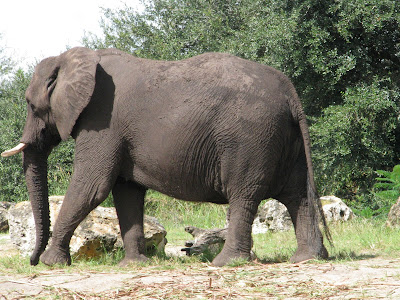The signature attraction at Disney's Animal Kingdom is not the one with the Yeti, but rather the one that covers about the same amount of land as the entire Magic Kingdom. Of course I'm referring to Kilimanjaro Safaris.
Kilimanjaro Safaris
The back story for the Kilimanjaro Safaris takes place in the Harambe Wildlife Reserve near the village of Harambe. At one time this area was known as a place to come to hunt wild game. Some time in the 1970's the people of Harambe started becoming more concerned with the environment and decided to change how the land was being used. The Reserve was changed to a place where the animals were protected and the only safaris that were permitted were of the photo taking variety. Now the Reserve Wardens struggle against poachers to keep the animals safe from harm.
For the Disney World guest they are welcomed to a 2 week safari as they board their Specially Designed Safari Vehicles. Here they will encounter a wide variety of African birds and mammals across this expansive terrain. Each of the animals will be seen in a natural habitat setting with room to roam. This is far different than your typical zoo display. The free roaming nature of the animals appears more realistic and the animals are more comfortable in their surroundings.
The landscaping for the Kilimanjaro Safaris may have been the greatest achievement, but hardly noticed by park guests. Starting with a nearly bare stretch of land, hundreds of thousands of plants were grown using varieties from all over the world. The plants serve many purposes from story telling, to barriers, to food for the animals. From early on, there was much trial and error to determine which plant varieties would hold up in the Florida Sun and withstand the animals. Some varieties that did not adapt well to these conditions were substituted with ones that did. The end result is a truly believable African landscape. Since this part of the park is truly alive and growing, it is a challenge for the Disney Imagineers to let the trees and plants grow and look natural, but still maintain control of the overall look of the Animal Kingdom Park.
The Animals
The African animals are the star of Kilimanjaro Safaris. This is what people come to see. Disney Imagineers took many research trips to Africa to go on photo safaris to be able to capture the look and feel of the experience.
As you make your way through the safari you are exposed to different habitats and different animal residents. The Tour Guides weave the descriptions together to make a smooth transition from one area to another and to point out the animals along the way. Having a top notch guide can definitely improve your Safari experience.
One of the first animals you may spy is the Okapi. This interesting animal has markings on its legs that make you think it is related to a zebra, but it is actually most closely related to the giraffe.
Pictured above is a Black Rhino. Fully grown adults can reach 3,000 lbs. They are considered to be critically endangered with only around 3,600 remaining in all of Africa.
The Hippo Pool is always home to numerous hippopotamuses. The Hippopotamus is the 3rd largest land mammal and believe or not is one of the most aggressive animals in Africa.
You will also find a number of native African birds like the ones pictured above while you take the Kilimanjaro Safari.
The Wildebeest is one of the more common animals on the African Savannahs. You will find this one in the Kilimanjaro Safari Savannah, along with Ankole Cattle, and a number of varieties of antelope.
There are many giraffes present at Disney's Animal Kingdom. They presented interesting challenges to the landscaping staff as they eat large quantities of leaves and can do a lot of damage to trees.
This baby elephant pictured above is one of the many elephants that you can see. There are animal births happening constantly around the Park and the young animals are always interesting to see. This little elephant was adorable.
Pictured above is a baby white rhino. The White Rhino is more plentiful than the Black Rhino and it is larger with some adults approaching 8,000 lbs. That makes it the 2nd largest land animal behind the elephant.
You will typically see ostriches walking around in the latter part of the Safari. The Ostrich eggs that your guide points out are fake, but they are actual size.
Must See Attraction For Entire Family
The Kilimanjaro Safaris is a must see attraction that appeals to the entire family. Each time you ride this attraction the ride is different, because unlike the Jungle Cruise these animals are all alive and move around as they desire.
This ride appeals to all age groups and it there are a lot of wonderful photo opportunities to get pictures of the animals. This is a must see attraction, and your visit to Disney's Animal Kingdom is not complete without doing the Safari. Note: FastPasses are available, so take advantage and avoid long waits in line!

























i went there only once.. but it was an lifelong experience for me. its really beauty to watch for.